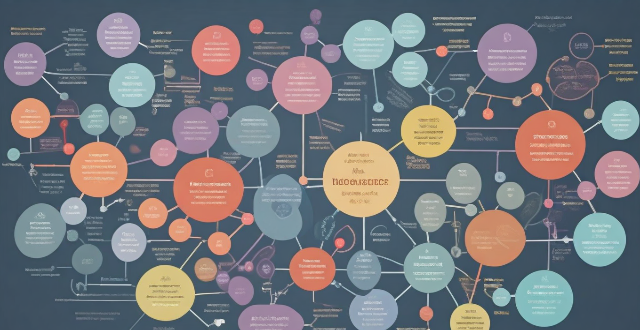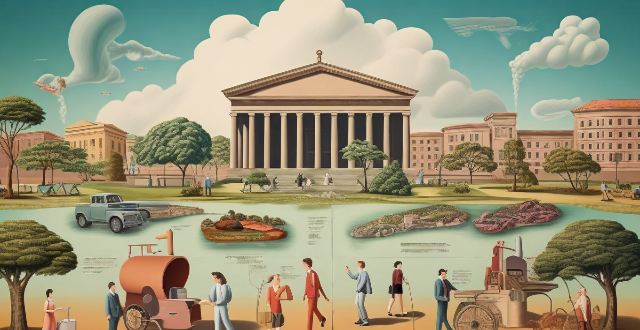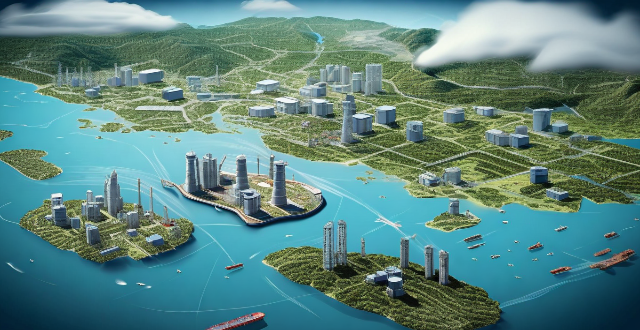Global Distribution

How can we ensure equitable distribution of vaccines and treatments for infectious diseases globally ?
The text discusses strategies to ensure equitable distribution of vaccines and treatments for infectious diseases globally. It suggests increasing production capacity through investing in research and development, expanding manufacturing capabilities, improving financing mechanisms by providing financial support to low-income countries and encouraging private sector participation, strengthening infrastructure and logistics through enhancing cold chain systems and developing distribution networks, promoting political will and global cooperation through advocating for international agreements and addressing intellectual property rights issues.

How can we ensure fair vaccine distribution globally ?
The text discusses the importance of ensuring fair vaccine distribution globally, emphasizing collaboration among nations, the role of international organizations, engagement of pharmaceutical companies, capacity building in developing countries, transparency and accountability, legal and ethical frameworks, and flexibility in approach. It suggests strategies such as sharing resources, knowledge exchange, coordination by organizations like WHO, monitoring distribution, fair pricing by companies, technology transfer, infrastructure development, training healthcare workers, open communication, public reporting, international agreements, ethical considerations, adaptive strategies, and continuous assessment to achieve equitable distribution. The conclusion highlights the need for a multifaceted approach involving collaboration, coordination, capacity building, transparency, and adaptability to ensure fair vaccine distribution globally.

What are the potential consequences of unequal vaccine distribution ?
The text discusses the potential consequences of unequal vaccine distribution, which include continued transmission and mutations of the virus, prolonged pandemic, economic disparities, educational setbacks, strain on healthcare systems, social inequality, global travel restrictions, political tensions, increased antimicrobial resistance, and mental health impact. These consequences highlight the importance of equitable vaccine distribution to effectively and efficiently end the COVID-19 pandemic.

How does vaccine distribution impact the economy ?
This text explores the relationship between vaccine distribution and its economic impacts, including public health, labor force participation, consumer behavior, and global supply chains. It highlights how equitable vaccine distribution can shape the trajectory of economic recovery by reducing transmission and mortality rates, increasing consumer confidence and spending, stabilizing the labor market, creating employment opportunities, shifting consumer preferences towards local products and services, stimulating discretionary spending on entertainment and travel, restoring supply chains and normalizing trade through reduced tariffs and increased international cooperation. The author emphasizes the importance of recognizing these relationships and crafting interventions that facilitate robust and sustained economic upturns.

How does equitable vaccine distribution affect public health outcomes ?
Equitable vaccine distribution is crucial for global health security, herd immunity, reduced disease severity, economic stability, and social equity. It leads to decreased transmission rates, improved global health indicators, increased trust in health systems, and enhanced research. However, logistical hurdles, political will, and resource allocation are challenges that must be addressed.

What role does the WHO play in promoting equitable vaccine distribution ?
The World Health Organization (WHO) is a key player in promoting equitable vaccine distribution globally. It does this through various programs such as the Vaccine Introduction Programme (VIP), partnerships like GAVI Alliance, and advocacy and policy development. The VIP helps countries plan and implement new vaccine introductions, while GAVI Alliance aims to increase access to vaccines in low-income countries. The WHO also advocates for policies that support equitable access to vaccines.

What is the definition of equitable vaccination distribution ?
Equitable vaccination distribution is the fair and just allocation of vaccines to all individuals, regardless of their socioeconomic status, race, ethnicity, or geographic location. It ensures that everyone has equal access to vaccines and can receive them in a timely manner. Key principles include fairness, transparency, solidarity, accountability, efficiency, respect for human rights, and scientific evidence-based decision making. Examples of equitable practices include prioritizing high-risk groups, addressing geographical disparities, promoting diversity and inclusion, and collaborating with international organizations. Equitable distribution is crucial for achieving herd immunity and ending the pandemic, protecting vulnerable populations, reducing health disparities, and saving lives.

What ethical considerations are involved in vaccine distribution equity ?
Vaccine distribution equity is a crucial issue that requires careful consideration of ethical principles such as justice, utilitarianism, autonomy, and transparency. Justice demands that vaccines be distributed based on medical need rather than wealth or social status, while utilitarianism emphasizes maximizing overall well-being by prioritizing essential workers and those who can contribute most to society. Autonomy requires respecting individuals' choices about whether or not to receive a vaccine through informed consent and voluntary participation. Transparency is essential for building trust and promoting public confidence in vaccine distribution efforts through public communication and accountability mechanisms. Overall, ensuring equitable distribution of vaccines requires balancing these ethical considerations to promote fairness, maximize benefits, respect individual autonomy, and maintain transparency throughout the process.

How can technology help in ensuring equitable vaccine distribution ?
Technology plays a crucial role in ensuring equitable vaccine distribution by providing data collection and analysis tools, managing logistics, and improving accessibility and outreach. Examples of technologies used for data collection and analysis include mobile apps, GPS tracking, and cloud computing. Technologies used for logistics management include RFID tags, drones, and automated warehouses. Examples of technologies used for accessibility and outreach include social media platforms, telehealth services, and chatbots. By leveraging these technologies, we can create a more efficient and effective vaccine distribution system that benefits everyone equally.

How might climate-induced natural disasters, such as droughts and floods, impact global food distribution ?
Climate-induced natural disasters significantly impact global food distribution by causing crop failures, livestock losses, and infrastructure damage. Droughts and floods reduce water availability for crops or wash away topsoil, leading to reduced yields or complete crop failures. Examples include wheat, corn, and rice production disruptions in major producing regions. Floods and droughts also lead to the loss of livestock like cattle, poultry, and sheep, affecting meat, dairy, and egg supplies. Infrastructure damage such as roads, bridges, ports, and storage facilities disrupts the supply chain, making it difficult to transport and store food. Understanding these impacts is crucial for preparing and mitigating their effects on food systems.

How does climate variability affect global weather patterns ?
The impact of climate variability on global weather patterns is substantial, affecting temperature, precipitation, wind patterns, and extreme weather events. Key influences include El Niño and La Niña phases, monsoon systems, altered rainfall distribution, jet stream variations, tropical cyclones, heatwaves, cold spells, storms, floods, and droughts. Long-term climate trends like global warming also significantly affect weather patterns. Understanding these interactions is crucial for predicting future conditions and addressing climate-related challenges.

What role does natural gas play in the global energy market ?
Natural gas is a key player in the global energy market due to its environmental advantages, economic benefits, contributions to energy security, technological advancements, and versatile applications across sectors.

How has the COVID-19 pandemic impacted global health security ?
The COVID-19 pandemic has significantly impacted global health security by overwhelming healthcare systems, necessitating public health policies such as lockdowns and quarantine measures, and highlighting the importance of international cooperation. The strain on healthcare systems included increased patient loads, shortages of medical supplies, and stress on the healthcare workforce. Public health responses involved vaccination programs, testing and tracing initiatives, and economic challenges due to lockdowns. International cooperation was essential for coordinating a global response, sharing information, and addressing misinformation. The pandemic also highlighted the need for resilient global health systems, sustained investment in public health infrastructure, collaborative research, and technological advancements. Overall, the COVID-19 crisis has prompted efforts to build stronger and more cooperative global health systems prepared for future emergencies.

How does vaccine distribution affect public health ?
Vaccine distribution is crucial for global health, reducing disease incidence and healthcare costs while increasing productivity. Challenges include inequitable access, logistical complexities, and public perception issues.

What are the potential long-term effects of global warming on ecosystems ?
Global warming, caused by greenhouse gases, can have severe impacts on ecosystems worldwide. Potential long-term effects include species extinction, changes in distribution and abundance of species, alteration of ecosystem functions, loss of habitat due to rising sea levels, and invasion of non-native species. These impacts underscore the need for action to mitigate climate change and protect ecosystems.

What are the ethical considerations in vaccine distribution ?
Vaccine distribution is a complex process that involves several ethical considerations. These considerations are crucial to ensure that the distribution is fair, just, and equitable. Here are some of the key ethical considerations in vaccine distribution: ## Fairness One of the most important ethical considerations in vaccine distribution is fairness. This means that everyone should have an equal opportunity to access the vaccine, regardless of their socioeconomic status, race, ethnicity, or geographic location. To achieve this, it is essential to establish transparent criteria for prioritizing groups for vaccination. ### Criteria for Prioritization - **Healthcare workers and first responders**: These individuals are at high risk of exposure to the virus and play a critical role in managing the pandemic. - **High-risk individuals**: People with underlying medical conditions or compromised immune systems are more susceptible to severe illness from COVID-19. - **Vulnerable populations**: Elderly adults, people living in congregate settings (such as prisons or homeless shelters), and those with limited access to healthcare should be prioritized. - **Essential workers**: Workers in critical infrastructure sectors, such as transportation, food production, and energy, should be given priority to maintain societal functioning. ## Justice Another ethical consideration in vaccine distribution is justice. This involves ensuring that the distribution process does not exacerbate existing inequalities or create new ones. For example, if only wealthy countries receive vaccines while poorer nations are left without adequate access, this could perpetuate global health disparities. ### Addressing Inequalities - **Global cooperation**: International collaboration is essential to ensure equitable vaccine distribution worldwide. - **Financial support**: Wealthy nations and organizations should provide financial assistance to help low-income countries acquire vaccines. - **Technology transfer**: Sharing knowledge and technology related to vaccine production can help increase global capacity and reduce dependence on a few manufacturers. ## Transparency Transparency is also a crucial ethical consideration in vaccine distribution. This includes being open about the decision-making process, criteria for prioritization, and progress in vaccine distribution. Transparency helps build trust among the public and ensures that the process is accountable and subject to scrutiny. ### Enhancing Transparency - **Public communication**: Regular updates on vaccine distribution plans and progress should be provided through various channels, such as government websites, social media, and press conferences. - **Stakeholder involvement**: Engaging with community leaders, advocacy groups, and other stakeholders can help ensure that diverse perspectives are considered in the decision-making process. - **Data sharing**: Providing access to data on vaccine supply, allocation, and administration can help monitor progress and identify areas for improvement.

What is the role of international organizations in vaccine distribution ?
International organizations play a crucial role in vaccine distribution, focusing on equitable access for all countries. They achieve this through advocacy, funding, technical assistance, and coordination of global efforts. Examples include the World Health Organization (WHO) advocating for a "people's vaccine," the Global Alliance for Vaccines and Immunization (GAVI) providing funding for vaccines in poorer countries, and the COVAX Facility coordinating global efforts for equitable COVID-19 vaccine distribution.

What challenges have been faced in vaccine distribution ?
Vaccine distribution faces challenges in manufacturing capacity, logistics, geopolitics, regulatory approvals, public perception, financial constraints, technology, and coordination efforts. Addressing these requires global collaboration to ensure equitable access to vaccines worldwide.

What challenges do countries face when working together on a global scale ?
Global collaboration faces political, economic, cultural, and logistical challenges. Politically, differing national interests, sovereignty concerns, and leadership dynamics can impede progress. Economically, fair resource allocation, trade agreements, and sanctions are contentious issues. Culturally, language barriers, diverse values, and educational gaps pose challenges. Logistically, coordination across time zones, travel restrictions, and technology disparities complicate matters. Addressing these challenges with open dialogue and cooperation is key to achieving shared global goals.

Is geoengineering a viable solution to global warming ?
Geoengineering, also known as climate engineering or earth system management, refers to the intentional manipulation of the global climate on a large scale to counteract the effects of global warming and reduce the risks associated with climate change. While geoengineering has potential benefits such as mitigating climate change, providing faster responses compared to conventional methods, and being relatively inexpensive, it also comes with uncertainties regarding long-term effects, lack of international regulation and governance, and limited scope compared to other mitigation strategies. Therefore, geoengineering should not be seen as a substitute for conventional mitigation strategies but rather complement them. Extensive research and international cooperation are essential before implementing any large-scale geoengineering projects to ensure their safety and effectiveness in addressing climate change challenges.

What are the challenges in ensuring fair distribution of vaccines ?
The text discusses the challenges in ensuring fair distribution of vaccines, which include production and manufacturing capacity, logistics and supply chain management, allocation and prioritization, political and economic factors, and information and education. These challenges require coordinated efforts at local, national, and international levels to achieve equitable access to vaccines for all people around the world.

Is there a fair system for vaccine distribution ?
Vaccine distribution is a complex process impacted by various factors, including geographical location, economic status, population size, healthcare infrastructure, and political will. Evaluating fairness involves considering equity, transparency, accountability, efficiency, and responsiveness. Challenges such as insufficient supply and lack of coordination must be addressed through increased production, pooling resources, strengthening cooperation, and promoting education and trust.

What are the economic implications of global warming for different countries ?
Global warming has significant economic implications for countries worldwide, affecting sectors like agriculture, health, infrastructure, insurance, energy, and labor markets. Developing nations often face challenges related to food security, health concerns, and infrastructure damage due to extreme weather events. Developed nations may see impacts on insurance and property markets, the energy sector, and labor productivity. Globally, there can be trade disruptions, migration and security issues, and financial market fluctuations. Coordinated international efforts are crucial to mitigate these effects and adapt to the changing environment.

What are the impacts of global warming on marine life and fish populations ?
The provided text discusses the impacts of global warming on marine life, particularly fish populations. It outlines how rising ocean temperatures alter habitats and affect metabolic rates; how ocean acidification disrupts calcification processes; how changes in currents and water circulation alter migration patterns and species ranges; the loss of coral reefs and its implications; the effects of extreme weather events on marine environments; and the challenges these changes present for resource management. The conclusion emphasizes the need for collective efforts to mitigate the effects of global warming on oceans.

What factors influence vaccine distribution ?
Vaccine distribution is a complex process influenced by various factors, including production, logistics, and demand. Key factors include the availability of raw materials, manufacturing capacity, quality control measures, transportation infrastructure, cold chain maintenance, staff training, population size, geographic location, and public perception and trust. Addressing these factors is crucial for ensuring effective and efficient vaccine distribution to those who need it most.

How can international cooperation on climate change contribute to global security ?
International cooperation on climate change is vital for global security. It helps mitigate environmental disasters, promotes economic stability and growth, enhances social cohesion and peace, facilitates technology and knowledge sharing, and strengthens global governance and diplomacy. Through joint efforts, nations can address one of the most pressing challenges of our time and secure a safer future for all.

What are the latest trends in the global economy ?
The global economy is influenced by various interconnected factors including digital transformation, sustainability, global trade dynamics, monetary policies, and the rising influence of emerging markets. These trends are reshaping industries, fostering innovation, and influencing economic growth and policies worldwide.

How can we ensure equitable access to vaccines and medical treatments during global health crises ?
Strategies to ensure equitable access to vaccines and medical treatments during global health crises include: 1. **Global Cooperation**: Sharing information, joint research, and collaborative efforts between countries and pharmaceutical companies. 2. **Fair Distribution**: Mechanisms like COVAX and the WHO's Vaccine Allocation Framework to guide equitable distribution. 3. **Affordability and Financing**: Tiered pricing and financial support from institutions like the Global Fund and GAVI. 4. **Capacity Building**: Investing in healthcare infrastructure and providing technical assistance to under-resourced areas. 5. **Transparency and Accountability**: Monitoring systems and public engagement to promote trust and encourage uptake.

How might climate change influence the distribution and abundance of aquatic species ?
Climate change significantly impacts the distribution and abundance of aquatic species by altering water temperature, pH levels, salinity, and oxygen availability. These changes affect habitats and life cycles of aquatic organisms, causing direct and indirect effects on their survival, growth, reproduction, and community interactions. Some species show resilience through genetic adaptation or phenotypic plasticity. Proactive conservation efforts are crucial for maintaining biodiversity and ecosystem health amid climate shifts.

How is climate change affecting global water resources ?
The impacts of climate change on global water resources include reduced availability due to melting snowpack and glaciers, more frequent droughts and floods, saltwater intrusion into coastal aquifers, and changes in runoff patterns. Water quality is also affected by warmer water temperatures leading to harmful algal blooms, acid rain from increased carbon dioxide levels, pollutant transport from heavy rainfall events, and eutrophication from nutrient loading. The distribution of water resources is impacted by increased water stress in arid regions, migration and displacement of people seeking reliable water sources, strain on infrastructure from extreme weather events, and disruption of aquatic ecosystems due to altered flow regimes. Addressing these challenges requires both mitigation efforts to reduce greenhouse gas emissions and adaptation measures to build resilience against the impacts of climate change on water resources.